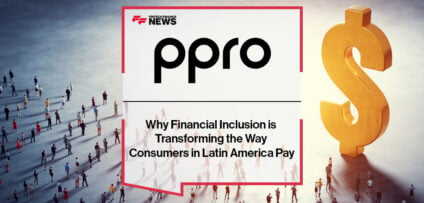Breaking News

My Fintech Company Started in Southeast Asia Ten Years Ago. Now 50% of Our Revenue Comes from LATAM. Here’s Why the U.S. Is Losing the Fintech Innovation Race
We launched our fintech company in Singapore in 2016. The plan was to establish our roots in Southeast Asia, and grow outwards throughout the next decade across the U.S. and Europe.
However, by 2024, nearly 50% of company revenue was coming from Latin America.
We initially explored LATAM primarily out of curiosity, back when our broader expansion plan was still focused on Europe and the U.S. What we found was a region primed for fintech innovation, and a burgeoning economic powerhouse. Latin America was beginning to flex its economic muscle, and in the process turning into a magnet for agile, high-impact financial technology that’s facing stronger headwinds in the U.S. and Europe.
We weren’t the only ones who noticed. Although European neobanks still tend to focus their expansion plans on the U.S., typically with limited results, Asian (and particularly Chinese) neobanks have shifted focus to Latin America and beyond. The next battleground for global fintech isn’t San Francisco or London. It’s Mexico City, São Paulo, and Bogotá.
The myth of the U.S. fintech opportunity
By now, the crash-and-burn story of a European neobank entering the U.S. is a cliché. N26, Monzo, and Klarna all broached the U.S. market with enormous ambitions and all-but-assured success, only to experience delays and obstacles bad enough to prompt major scale-backs and exits.
The U.S., at least in theory, offers scale. But meaningful growth in the country requires companies to comply with dense regulation, field high customer‑acquisition costs, and navigate fragmented financial rails still unsuited to true open finance. It’s a high obstacle, high reward market. Many companies underestimate the regulatory no-man’s land and obstacles they’ll face within the U.S.: a state-by-state licensing regime, no federal fintech charter, regulatory fragmentation that creates duplicative oversight and compliance ambiguity, overwhelming dependency on bank partnerships, and overreliance on ACH instead of real-time payments.
The U.S.’s prime positioning has overshadowed markets that are better suited and more specifically regulated for fintech companies. Latin America and Southeast Asia are superior regions for fintech because their markets and regulations have been designed and redesigned with modern finance in mind. Regulators in Singapore, Indonesia, Colombia and Brazil now host active fintech sandboxes that don’t just permit experimentation but encourage it. The U.S., on the other hand, lacks a regulatory framework open to fintech innovations. Even the CFPB’s proposed open‑banking rule (Section 1033 of Dodd‑Frank) faces legal setbacks and potential repeal, which would only make the situation worse for fintechs trying to break into the U.S. market.
LATAM and SEA: more alike than you think
When we entered Latin America in 2022, every prospect asked the same thing: “What’s your track record in this market?” We had none, and we admitted that.
Instead we made our case by highlighting the structural parallels between Southeast Asia and Latin America: similar smartphone penetration, GDP per capita, digital adoption curves, and limited traditional credit access. Thankfully, this was enough to convince a handful of early clients.
Three years later, we generated the same amount of revenue from LATAM as we had initially from Southeast Asia. It wasn’t an accident—our product was suited to it—but it was a case of being in the right place at the right time.
In the U.S. and Europe, fintech has become about marginal gains and better user experience. In LATAM and Southeast Asia, it’s about solving fundamental access problems. Both regions face structural bottlenecks in their traditional financial systems, meaning fintech is necessarily attached to providing first-time access to core financial services. According to Latin America Reports, 7 in 10 Latin Americans are unbanked or underbanked, which has helped perpetuate its outsized income inequality. The SEA countries have comparable statistics.
A recent report by Japanese consumer finance company Credit Saison found that LATAM and SEA are primed for growth in almost identical ways, thanks to key demographic similarities and increasing levels of investment. In other words, cross-regional expansion here makes sense for stakeholders with shared business models that can scale.
Super‑apps on the march
Latin America, like Southeast Asia, has embraced super‑apps.
In Asia, Grab links ride‑hailing, payments, lending, insurance. In LATAM, Rappi and Nubank serve similar roles. They’re with users throughout the day, which creates data loyalty and scale. This kind of loyalty is virtually unheard of in the U.S. and Europe.
The only European banks with a rock-solid LATAM integration are BBVA and Santander, both legacy players that entered decades ago. Fintech-native platforms are moving faster, growing faster, and winning customer trust at scale. They’re also reflecting a broader geopolitical realignment. Asian fintech companies, such as China’s Fintopia, have made huge strides in Latin America. In Brazil, Chinese e-commerce platform Temu has rapidly gained, trailing only the Singaporean platform Shopee, which leads the market with over 50 million active users. Fintech is beginning to emerge as a key dimension within global trade competition.
LATAM is fintech’s next frontier, and others are catching on
For European neobanks, the alluring prestige of the U.S. should no longer outweigh the stronger demographic tailwinds, faster adoption cycles, and more welcoming regulators of LATAM. Homegrown success stories are proof of its potential: Brazilian neobank Nubank surpassed 100 million customers last year—more than most of its European challengers combined. While fintech giants struggle to gain ground in the U.S., LATAM-based platforms are looking outward. Don’t be surprised if, in a few years, it’s Nubank expanding into New York, rather than the other way around.
Global fintech is, in a word, migrating. LATAM and Southeast Asia are no longer emerging markets. They’re leapfrog markets forcing a new mental model for founders, investors, and strategists alike. The U.S. will likely always be a behemoth. But if you want to see where the real innovation is happening, look further east or straight south.
People In This Post
Companies In This Post
- RBC Capital Markets on Corporate Digital Identity Read more
- How U.S. Bank Sees SMBs Navigating Tariffs and GenAI Read more
- FinTech Connect Turns 10: The UK’s Biggest Fintech Event Returns This December Read more
- Bank of America Modernises EMEA Payments With ISO 20022 & SEPA Instant Read more
- EXCLUSIVE: “Face The Truth” – Ron Delnevo in ‘The Fintech Magazine’ Read more

















